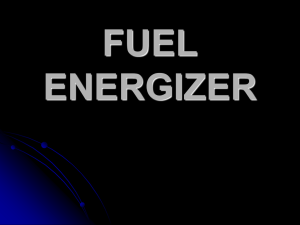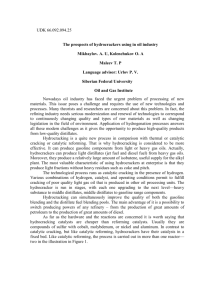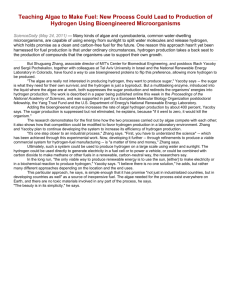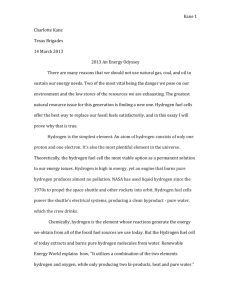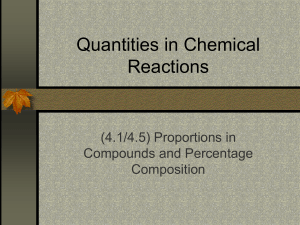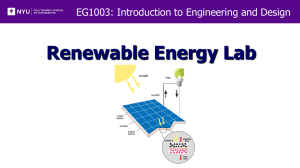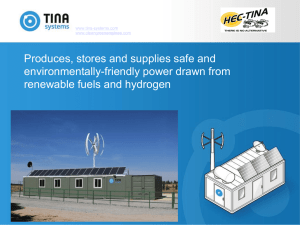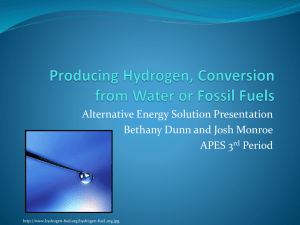Liquid Organic Hydrogen Carrier Distribution Network
advertisement
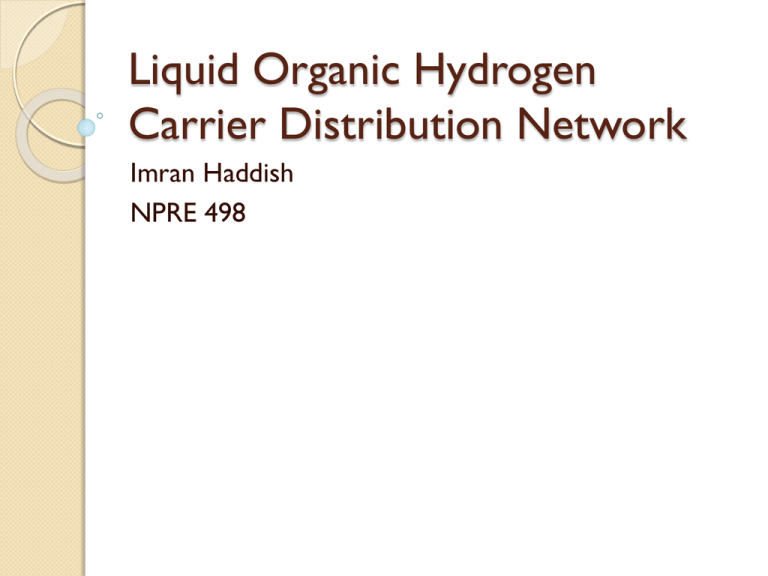
Liquid Organic Hydrogen Carrier Distribution Network Imran Haddish NPRE 498 Content What is an LOHC Types of LOHC compounds Overall benefits of an LOHC network Integration with renewable energies Mobile Applications Shortcomings and future work LOHC Compounds Energy carrying compounds Exists in an energy-rich and energy-lean state Have high energy density Easily stored under ambient conditions Stored hydrogen is easily released in a catalytic dehydrogenation reaction Types of LOHC Compounds N-ethylcarbazole Hydrnol (C5H12S (liquid) + Heat/Catalyst 3H2 (gas) +C5H6S (liquid) Hydrogenation & Dehydrogenation Hydrnol can be made from: ◦ Feed stocks Sweet and sour crude oil ◦ Alcohols Ethanol from biomass Hydrogenation (perhydro-N-ethylcarbazole) ◦ Hydrogen capacity of 5.8 wt% ◦ Reaction at 145 oC & 70 bars ◦ Catalyzed with Ruthenium Dehydrogenation (N-ethylcarbazole) ◦ Reaction at 215 oC & ambient pressure ◦ Catalyzed with platinum or palladium LOHC Cycle Overall Benefits Used in a cyclic manner (loading/unloading) Many physico-chemical similarities to diesel ◦ Preserve our current infrastructrue ◦ Introduce LOHC network gradually Allows steady power delivery for intermittent power sources Integration with Renewable Energy Sources Renewable energy sources suffer from negative prices ◦ When production is higher than demand, renewable energy is sold at negative prices More high voltage lines and amplification are needed to expand renewable energy sources LOHC Solution LOHC compounds can be utilized at the site of renewable energies or transported elsewhere Benefits of on-site utilization LOHC tanks store excess energy Hydrogenated compounds can generate power ondemand Energy can now be load-following No need for amplification of electric grid Higher stability LOHC Solution LOHC vs. Other Storage Methods Hydroelectric storage ◦ Cheap but low storage density ◦ Space is running out Gaseous hydrogen storage ◦ Higher storage density than hydroelectric but still relatively low ◦ Requires large amount of space People do not want to live near or above storage facilities LOHC Storage ◦ Same tanks as fossil fuels ◦ Can be stored for long periods of time (Stable) Mobile Applications LOHC will provide a safer & more economical approach Liquid hydrogen & compressed hydrogen ◦ Operate at extreme temperatures & pressures ◦ Conditions not common & potentially unsafe ◦ No established supply system LOHC Based Vehicles Attain same range and fuel capacity as gasoline ◦ 100 liters of LOHC for 500 kilometers Hydrogen extracted with catalytic device ◦ Requires heat to operate Combustion Engine ◦ Burns hydrogen and supplies heat to catalytic device Fuel Cell ◦ Hydrogen will need to be burned to maintain catalytic device temperature Reduces efficiency as 20% of hydrogen is burned Hydrnol Efficiency Model assumes internal combustion engine Overall efficiency is 25% ◦ Higher than gasoline efficiency of 14% Catalytic Device Keys to success ◦ High surface area Units consist of micro-channels, packed bed made out of embedded nano-size catalysts on porous substrates and nano-springs ◦ Stability of the catalyst LOHC Vehicle Refueling Rehydrogenation will generate around 600kW of heat ◦ Unsafe for gasoline station LOHC fuel can still be swapped at gasoline stations ◦ Forces rehydrogenation to occur at specialized facility Excess heat can be recycled Facilities will need to be outfitted with return lines for dehydrogenated LOHC On-board Hydrogen Storage Systems Overall Cost of Hydrnol Installing LOHC pumps at gas station ◦ $200,000 to $300,000 Installing new LOHC fueling station ◦ $1 million to $4 million Providing 70% of US population with LOHC fueling stations (12,000 stations) ◦ $24 billion Delivery Cost of Hydrnol Shortcomings of LOHC network Required components are still in development Some LOHC compounds are solid when 100% dehydrogenated ◦ Results in less efficiency by reducing capacity Noble metals will increase the price of catalytic devices There isn’t a solution to combine a fuel cell with LOHC storage Sources ◦ http://www.prnewswire.com/news-releases/vision-licensesorganic-liquid-hydrogen-carrier-adds-fuel-to-its-line-ofhydrogen-solutions-plans-nationwide-roll-out94816234.html ◦ https://netfiles.uiuc.edu/mmazzocc/shared/OVCR%20Files/ Asemblon/Asemblon-ppt.pdf ◦ http://www.sigmaaldrich.com/technicaldocuments/articles/material-matters/introducinghydrnol.html ◦ http://www.hydrogencarsnow.com/blog2/index.php/hydrog en-fuel-distribution/asemblon-hydrnol-hydrogen-carrierwill-reduce-infrastructure-costs/ ◦ http://pubs.rsc.org/en/content/articlehtml/2011/ee/c1ee01 454d



